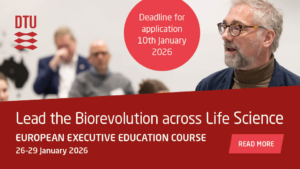
IMI AMR Accelerator: Allow the few to make the most of their resources
In 2019, a new AMR accelerator kicked off under the aegis of the Innovative Medicines Initiative as a follow-up and evolutive next step to the former New Drugs for Bad Bugs programme. European Biotechnology spoke with Rob Stavenger, its coordinator at GlaxoSmithKline, about the goals of the €295m initiative, its cooperation with SMEs, and the relevance of push and pull incentives in the field.
Robert Stavenger, whose career at GlaxoSmithKline has spanned over 18 years, has focused on cardiovascular and antibacterial drug discovery. He was involved in the creation of IMI’s New Drugs for Bad Bugs programme and the AMR Accelerator as mechanisms for promoting collaboration in antibacterial R&D.
EuroBiotech: What reasons were there to add six new years of funding in the AMR field through an IMI AMR Accelerator, particularly in light of the fact that just 2-3 Big Pharma firms remain committed to the field of antibiotics R&D?
Stavenger: That only a few Big Pharma players are left is precisely why big, impactful PPPs like the Accelerator are critical for developing the antibiotic pipeline. These projects allow the few remaining companies in the field to make the most of their limited resources. In addition, we expect that the Accelerator will strengthen ties between SMEs, and potentially encourage other pharmas back to the field. We are also optimistic that new funding incentives will be created as we deliver new options for patients within the Accelerator. TB is an example where other PPPs and funding agencies have committed major funding.
EuroBiotech: What are the Accelerator’s main objectives, structure, budget and time frames?
Stavenger: The overall goal is to progress a pipeline of potential medicines to treat patients with resistant bacterial infections – including tuberculosis. If fully successful, projects in the Accelerator could deliver up to >10 new preclinical candidates and >5 ‘Phase II-ready’ compounds over a six-year period. The Accelerator currently consists of three Pillars or Networks. First is a Capability Building Network – a €25m project focused on supporting all Accelerator projects. It’s in charge of analysis and improvement of animal infection models and their translation to the clinic. Second is the TB Drug Development Network – a €210m project aimed at developing and progressing new potential medicines for TB up to completion of Phase I clinical studies. Third is the Portfolio Building Network – a series of five projects with a total current budget of €60m – which are designed to discover, develop and accelerate potential drugs for bacterial and tubercular infections.
EuroBiotech: Which EFPIA partners are involved, and what role is GSK playing?
Stavenger: The EFPIA partners currently involved are GSK, Evotec and Janssen. In addition, in the Pillar B “TB Drug Development Network” project, the Bill and Melinda Gates Foundation, TB Alliance and the University of Dundee (Drug Discovery Unit) are participating as IMI Associated Partners. GSK is the project lead for four of the projects: for Pillar A and Pillar B, as well as two of the five Pillar C projects (TRIC-TB and AB-DIRECT).
EuroBiotech: How were the programmes in the Accelerator selected? Will it be open for new applications?
Stavenger: The current projects (in Pillar B and C) were selected under competitive calls following standard IMI evaluation and selection processes. The deadline to submit a proposal to former IMI Calls for proposals are now over, so currently there is no possibility for new applicants. However, there may be potential for a new Call for Proposals under the IMI AMR Accelerator in 2020.
EuroBiotech: What kind of support is provided to R&D at SMEs, and what’s the mutual benefit for SMEs?
Stavenger: In the AMR Accelerator, SMEs have the chance to work closely with EFPIA companies and within the AMR network to develop individual antibiotic assets. The funding provided by the EU is critical to help SMEs progress antibiotic assets in this area of low ROI.
EuroBiotech: How will the IMI AMR Accelerator prevent duplicating work with regard to existing PPPs in the field (for instance, CARB-X, or GARDP)? How much interaction is planned??
Stavenger: That’s a specific goal of the Pillar A project, and may include for instance joint meetings. Details are currently being developed within the Pillar A work-plan.
EuroBiotech: How do you perceive the current political debate to push forward pull incentives? (e.g. DISARM in the US) Do you think it’s a precondition for Big Pharma’s engagement in AMR? Which kinds of incentives do you think policymakers should be pushing?
Stavenger: Despite a range of support from CARB-X, IMI and others, private investment into antibiotic R&D is insufficient to deliver a broad innovative pipeline. Many stakeholders, such as the G20, recognise that pull incentives would encourage more investment from both large and small companies into antibiotic R&D. The current debate on novel incentives, such as a Market Entry Reward, a Transferable Exclusivity Voucher, an innovative purchasing scheme like the one from DISARM, or that being piloted in the UK is very welcome. All of these could make a significant difference. However, what we are really looking for – what will make a difference to companies – will be when many leading governments start to implement such a scheme, rather than just talking about it.
EuroBiotech: How does the Accelerator address the issue of AMR spreading in developing countries that can’t afford innovative treatment approaches?
Stavenger: A substantial portion of the Accelerator is focused on the discovery and development of new treatments for TB, which is a significant unmet need worldwide and of particular impact in heavily populated developing nations.
See also our AMR articles:
"The AMR Business" PART I: click here
"The AMR Business" PART II: click here
New players to step into the AMR field
About the IMI AMR accelerator
In July 2018, the European Commission announced a new Antimicrobial Resistance (AMR) Accelerator Programme as part of new calls for proposals launched by the Innovative Medicines Initiative (IMI).
It’s set up as a public-priviate partnership between the pharma industry (represented by EFPIA) and the European Commission. The Accelerator complements and builds upon the IMI ND4BB programme, and will also work in close collaboration with existing AMR initiatives to battle the ever-evolving resistance landscape. In early 2019, the first projects within the Accelerator were officially selected for launch; further projects in the different pillars kicked off in summer or will start in late autumn. The scope of the AMR Accelerator is broad. Under one structure, it will address many of the scientific challenges posed by AMR, and will support the development of new ways to prevent AMR (including vaccines) and treatments (including new antibiotics). The programme comprises three pillars:
- Pillar A: Capability Building Network will coordinate the programme and carry out research to strengthen the scientific base in the field of AMR.
- Pillar B: The Tuberculosis Drug Development Network will work to accelerate the discovery of new combinations of drugs to treat TB.
- Pillar C: Portfolio Building Networks will support collaborative efforts to discover, develop and advance innovative agents to prevent or treat AMR.
More information: https://www.imi.europa.eu/projects-results/project-factsheets/amr-accelerator
Originally published in European Biotechnology Magazine, Autumn 2019 edition



 EC- press service
EC- press service Alexander Sievert Photography
Alexander Sievert Photography